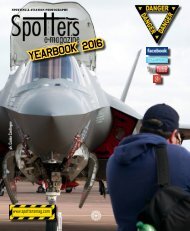You also want an ePaper? Increase the reach of your titles
YUMPU automatically turns print PDFs into web optimized ePapers that Google loves.
Ten. Pilot Dan Beshoar, Lieutenant<br />
Q: What made you become a pilot?<br />
A: Ever since I was young, I just really wanted to be a military pilot.<br />
I looked into the navy first, then the air force, and finally settled on<br />
the coast guard. I like the missions that we do; it’s about saving<br />
lives, not killing people, and that’s what I really liked about it. I<br />
had to try very hard to get my application in to become a pilot. I went<br />
through two years of school , and now I am here in San Diego.<br />
Q: How is the feeling with your team?<br />
A: It’s great. We have a very cohesive team. We communicate, we talk<br />
about the mission. It’s really amazing how we can come together and<br />
pull the mission off. When there’s a challenge, and something that is<br />
going to be really difficult, it’s amazing what the team can come up<br />
with, their thoughts and solutions.<br />
Q: Who works on your team?<br />
A: Any time we go flying as a duty crew, it’s going to be two pilots<br />
and a flight mechanic and a rescue swimmer in back. The pilots are<br />
flying in front, the flight mech is in the back working the hoist, and<br />
if we are near a boat, the flight mech will tell the pilots where we<br />
need to be moving, left, right or back, to get us in the right position<br />
to lower the rescuer swimmer down to swim and rescue the survivors. He<br />
also runs the communications in back.<br />
Q: Do other pilots from other countries / departments work with you?<br />
Q: How much time does it take to start flying from the rescue request<br />
A: Typically if it’s something that is an emergency and we know there<br />
are people in the water… from waking up (if we are across the bay<br />
sleeping) we are required to be in the air within 30 minutes, but<br />
sometimes as quickly as 20, depending on how long it takes to get<br />
airborne and on the way.<br />
Q: How many hours of training in a year to maintain your flying<br />
license?<br />
A: Typically an average pilot is flying 240 hours a year; 60 hours<br />
would be the bare minimum, but the average is 240 hours.<br />
Q: What was your hardest mission?<br />
A: The hardest mission I’ve had so far was probably three months ago.<br />
A gentleman was on a sailboat, trying to sail from San Diego to Hawaii,<br />
he was going into diabetic shock, having seizures, vomiting, delusions.<br />
We had to get him, he was 400 miles west of San Diego. The range of our<br />
helicopter is 300 miles, out and back. So we were trying to figure out<br />
fuel planning; we ended up on a coast guard cutter landing and getting<br />
fuel; went out, and the sail boat was a difficult hoist and we spent<br />
way more time on the scene than we wanted. We ended up going back to the<br />
cutter to get more fuel. We were able to eventually get him home, but<br />
it was a very difficult case, especially being 400 miles offshore. If<br />
something were to happen to us, it would be a long time before someone<br />
would be able to come and get us. It was definitely a challenging case.<br />
A: I know we have an exchange program with other countries, Great<br />
Britain and one with Canada as well. I know those two countries we have<br />
partnerships with.<br />
<strong>Spotters</strong> <strong>Magazine</strong> 191




